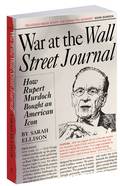 Ellison, Sarah - War at The Wall Street Journal: How Rupert Murdoch Bought an American Icon,
Ellison, Sarah - War at The Wall Street Journal: How Rupert Murdoch Bought an American Icon,
The Text Publishing Company Melbourne 2010, (pp 274)
SBN-13: 9781921656583
The writing was on the wall for journalists at The Wall Street Journal when new owner Rupert Murdoch told them in no uncertain terms that they were to write stories that people wanted to read instead of stories to win Pulitzer prizes. “Don’t confuse the time you spend on a story with the need for length in writing it. A story is a story and should be told in as few words in possible,” he told them.
For them, it was almost the worst-case scenario to result from what was billed as perhaps the last major print media deal – Murdoch’s purchase of Dow Jones and The Wall Street Journal. All the things that formed The Journal’s sense of purpose and importance were under attack – long form journalism, avoiding hard news, features on the front page. But the alternative was no future at all because the paper was losing money big-time. In this environment, The Wall Street Journal was defenseless against Murdoch, who had been waiting for years for the right moment to pounce.
Journal reporter Sarah Ellison won praise for her coverage of the sale of The Journal by the dysfunctional Bancrofts, descendents of the original owner. She clearly knows a lot about the family and the history of The Journal and is in her element discussing the financial machinations. She also raises significant questions about the future of print journalism in the United States, the decline of newspaper readership, the rise of online journalism. And finally, she seeks to understand the impact of the News Corp media strategy.
For readers in Australia and the United Kingdom more familiar with Murdoch’s game plan for newspapers, the news comes as no surprise. After all his “inform, educate and entertain” approach hasn’t varied in the 50 years that Murdoch has been in the business.
But the most fascinating part of the book is her insights into Murdoch’s world. She describes how, like so many editors before them, a series of editors cling to the idea that they will be the exception, the one to make it work with Murdoch, despite all evidence to the contrary.
Back in 1993, William Shawcross quoted the following observation from former London Times editor Harold Evans in his Rupert Murdoch: Ringmaster of the Information Circus (Pan Books: 1993). “ ‘Every editor, and many a politician who deals with Murdoch, thinks that they’re the one who is really going to change him. They’re like a woman who goes out with a womanizer. This time he really means it. He really loves me. He’ll really love me.’ Well Murdoch’s like a womanizer in that sense. His has this fatal capacity to instill confidence in you that you and he have a special, exclusive relationship. It’s a wonderful con trick” (Shawcross, 1993: 236).
The book has many insights into the functioning of the Murdoch dynasty as Murdoch heads into his eighties. Ellison also reports titillating tidbits about Wendi Deng, Murdoch’s Chinese-born American third wife, such as her alleged history as a seducer of older men. There are glimpses into Murdoch’s life with his two small daughters – he spends time with them on his boat Rosehearty, but he spends it in his office on the phone.
Ellison has her own take on the relationships within the Murdoch family, especially as they are related to the business. There is a fascinating description of how Lachlan Murdoch, so long agreed as heir-apparent to the News empire, came to leave the business. According to Ellison, he was victim of a ‘corporate conspiracy to undermine him’ but the real tragedy was that when Lachlan faltered, his father allowed it to happen. Ellison quotes Murdoch’s second daughter, Elisabeth, on her father’s reaction. “It wasn’t the most emotionally intelligent way for Dad to handle it,” she said. “He doesn’t really have the tools to express that he’s sorry.” That the grown children still stand resolutely by their father no matter what he does is also a telling insight.
Back at The Wall Street Journal, its most respected feature writers voted on the new order with their feet in 2009 and The Journal stopped winning Pulitzer Prizes for the first time in 10 years, as if proof of the folly of Murdoch’s approach. But in the autumn of 2009, The Journal’s (paid) online circulation reached 2.02 million, making it the largest paper in the nation.
As for the Bancrofts once so divided by their ‘duty’ to The Journal, they were now of a single mind that selling off the family legacy has saved them ‘from ruin’ even if they thought the paper had not changed for the better.
Ellison also tells how a New York Times business columnist described the demise of the old Journal. “Most painful for me are the memories I have of the rollicking Wall St Journal narrative that was such a staple – a behind-the-scenes story about some shenanigans inside a company that only The Journal would ferret out and tell. Nobody else wrote those stories on a regular basis and now that The Journal has largely stopped writing them I fear they are doing to disappear like an ancient dialect that dies out.” An ancient dialect in a Murdoch publication? Hardly.
“We produced a better paper,” Murdoch told his critics, inside and outside the company. “I’m sorry but it is as simple as that.” There ends the lesson.
About the Author
Professor Lynette Sheridan Burns is the Head of the School of Communication Arts, University of Western Sydney. She has been a journalist for 25 years. Professor Burns is the author of Understanding Journalism (Sage: 2002).

